Red Yeast Rice: A Natural Ally for Healthy Cholesterol Levels

Red Yeast Rice: A Natural Ally for Healthy Cholesterol Levels
In the quest for heart health, many individuals are turning to natural remedies to manage their cholesterol levels. One such remedy gaining attention is red yeast rice, a fermented product that has been used in traditional Chinese medicine for centuries. But what exactly is red yeast rice, and how can it benefit your cholesterol levels? Let’s explore the science behind this powerful natural supplement.
What is Red Yeast Rice?
Red yeast rice is a type of fermented rice that gets its red color from a specific mold called Monascus purpureus. This fermentation process not only changes the rice’s color but also enhances its health-promoting properties. Traditionally used in Asian cuisine, red yeast rice is rich in bioactive compounds, including monacolins, sterols, and isoflavones, which contribute to its health benefits.
How Does Red Yeast Rice Help with Cholesterol?
The primary benefit of red yeast rice lies in its ability to help manage cholesterol levels, particularly LDL (low-density lipoprotein) cholesterol, often referred to as “bad” cholesterol. Here’s how it works:
1. Natural Statins
Red yeast rice contains monacolin K, a natural compound that is chemically identical to the active ingredient in the prescription statin medication lovastatin. Monacolin K works by inhibiting an enzyme in the liver that is responsible for cholesterol production. As a result, it can help lower total cholesterol levels, particularly LDL cholesterol, thereby reducing the risk of heart disease.
2. Antioxidant Properties
In addition to its cholesterol-lowering effects, red yeast rice is rich in antioxidants. These compounds help combat oxidative stress, which can damage blood vessels and lead to atherosclerosis (the buildup of plaques in the arteries). By protecting the cardiovascular system, red yeast rice supports overall heart health.
3. Improved Blood Circulation
Some studies suggest that red yeast rice may enhance blood circulation by improving endothelial function. The endothelium is the thin layer of cells lining the blood vessels, and its health is crucial for maintaining normal blood flow and preventing cardiovascular diseases.
Potential Health Benefits of Red Yeast Rice
Beyond cholesterol management, red yeast rice may offer several other health benefits:
- Weight Management: Some research indicates that red yeast rice may aid in weight loss and fat reduction, which can further improve cholesterol levels.
- Blood Sugar Regulation: Preliminary studies suggest that red yeast rice may help regulate blood sugar levels, making it a potential ally for individuals with diabetes.
- Digestive Health: The fermentation process enhances the bioavailability of nutrients, which can support gut health and digestion.
How to Incorporate Red Yeast Rice into Your Diet
Red yeast rice is available in various forms, including capsules, powders, and as a food ingredient. Here are some ways to incorporate it into your routine:
- Supplements: Look for high-quality red yeast rice supplements that specify the amount of monacolin K per serving. Consult with a healthcare provider for the appropriate dosage.
- Culinary Uses: In Asian cuisine, red yeast rice is often used to color and flavor dishes like rice, noodles, and meat. You can find red yeast rice in specialty stores or online.
Safety and Precautions
While red yeast rice is generally safe for most people, there are some precautions to consider:
- Medication Interactions: Because red yeast rice acts like statins, it may interact with other medications, particularly those that affect liver function. Always consult your healthcare provider before starting any new supplement.
- Potential Side Effects: Some individuals may experience side effects similar to those of statins, including muscle pain, digestive issues, or liver enzyme elevations. Monitor your health and report any unusual symptoms to your doctor.
- Quality Matters: Not all red yeast rice products are created equal. Look for products that are tested for quality and purity to ensure safety and efficacy.
Conclusion
Red yeast rice is a promising natural option for individuals looking to manage their cholesterol levels and support overall heart health. With its natural statin-like properties and antioxidant benefits, it can be a valuable addition to a heart-healthy lifestyle. As with any supplement, it’s essential to approach red yeast rice with informed caution and consult your healthcare provider before incorporating it into your regimen.
Disclaimer: This article is for informational purposes only. Always consult with a healthcare provider before starting any supplement regimen or making changes to your health routine.
References
- Chuang, S. Y., et al. (2009). “Effects of Red Yeast Rice on Cholesterol Levels.” American Journal of Cardiology, 103(9): 1373-1378.
- He, K., et al. (2016). “Red yeast rice supplementation and the risk of cardiovascular disease: a systematic review and meta-analysis.” Nutrients, 8(8): 489.
- Liu, L., et al. (2014). “Efficacy of red yeast rice for dyslipidemia: a systematic review and meta-analysis.” Journal of Clinical Lipidology, 8(1): 49-58.
- Nascimento, A. L., et al. (2016). “Red yeast rice and cholesterol: a review.” The American Journal of Clinical Nutrition, 103(6): 1675S-1685S.
- Pahlavani, M., et al. (2020). “Red Yeast Rice: A Comprehensive Review.” Nutrition and Metabolism, 17: 18.